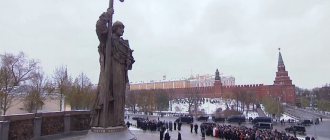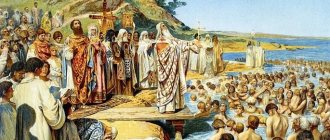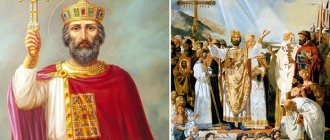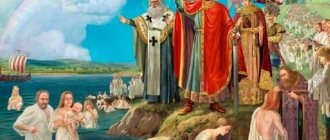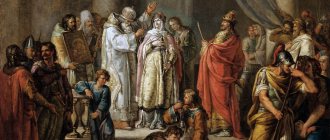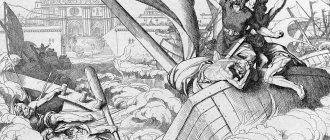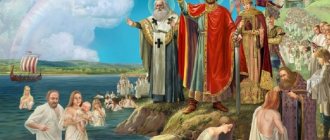The adoption of Christianity in Rus' contributed to the flourishing of the Russian state and subsequently determined the direction of its development. In the 10th century, objective reasons preceded the adoption of Christianity in Rus' and the state, torn apart by the internecine strife of numerous external enemies, was primarily interested in this. There was a need to unite the people in order to resist pagan polytheism, which required a unified ideology. At that time, Christianity was in all European states, and Rus' risked remaining in their eyes a “barbaric” country with its paganism.
The adoption of Christianity strengthened the international prestige of Rus', contributed to the expansion and strengthening of relations with Byzantium, and the further development of ties with Western countries and the southern Slavic world.
Prerequisites for the adoption of Christianity in Kievan Rus
According to historical sources, the adoption of Christianity in Rus' had its prerequisites. Against the backdrop of social and political factors, the need to strengthen the young state with a single idea and become a world power has become urgent.
Prince Vladimir and his retinue, in the late 980s, decided to change their faith after lengthy negotiations with states of different religions.
When choosing a state religion, Vladimir conducted a “test of faith” when embassies from Muslims were sent to Kyiv. From the Judaized Khazars and from Byzantium, everyone convinced the prince to accept their faith. But Vladimir himself sent his embassies “to the Germans,” “to the Bulgarians,” “to the Greeks” to “test their services.”
The ambassadors were struck by the beauty of Orthodox worship, which influenced the choice of Prince Vladimir; he decided in favor of Christianity.
However, the adoption of Christianity in the Orthodox version from Constantinople is also associated with the need to preserve important ties established with Byzantium earlier. The authority of the Byzantine Empire was also of great importance; at that time it was at the zenith of its power, being the center of civilization among European states.
Reasons for accepting Christianity
The main events that took place in Byzantium contributed to the adoption of Christianity in Rus'. The Byzantine Empire was going through difficult times in the late 90s of the 10th century. Emperor Vasily II needed help to suppress the rebellion, and he decided to turn to the Kyiv prince Vladimir. To which the prince agreed, but on condition of marriage with the emperor’s sister, Princess Anna.
A mandatory condition on the part of the emperor was the prince's acceptance of Christianity. In 988, Prince Vladimir and his retinue were baptized in Chersonesos, and only after that the wedding with Princess Anna took place.
Vladimir, having returned to Kyiv, turned to the people of Kiev with an offer to be baptized. This happened in 988, so this year of baptism is celebrated as the adoption of Christianity in Rus'.
There are other reasons that contribute to the adoption of Christianity. These include:
- the urgent need for the formation of a unified ideology in the state, which would spiritually unite the diverse peoples of Rus';
- strengthening ties with the peoples of Western countries;
- achieving a stable position for Rus';
- strengthening the power of Prince Vladimir;
- becoming an ally of Byzantium.
The choice of the Kyiv prince Vladimir fell on Christianity because there were contradictions in Islam to the established way of life, such as the ban on drinking wine, pork, as well as specific Eastern rituals (circumcision, horse slaughter).
Since Prince Vladimir set himself the goal of strengthening his power, he had no sympathy for Catholicism. Indeed, in Byzantium, the Orthodox Church in those years was politically helpless and completely subordinate to the emperors.
Even more prohibitions appeared in Judaism.
The Christian religion called for tolerance and forgiveness, it did not require sacrifices, did not divide peoples by nationality, and therefore the Russian prince chose Orthodoxy.
Social preconditions
The feudalization of the social system required not only economic changes, but also socio-cultural ones. The fragmentation and fragmentation of the Slavic tribes of the 7th-8th centuries, which reached the point of division not just into family farms, but even into separate farmsteads, was gradually replaced by the opposite process - centralization. By uniting once again fragmented economies into a single whole - settlements, cities, and then principalities, centralization led to the emergence of strong states. However, the key to the stability of such associations is not only territorial, but also spiritual integrity.
Existing beliefs - paganism - reflected the early fragmentation of the Slavic people. Each tribe had its own supreme god, who provided protection only to his own people and demanded appropriate rituals. Polytheism - polytheism - aggravated the discord between the Slavs and slowed down the process of centralization.
The new state, which united several dozen tribes into a single whole, required a single religion that could become those “spiritual bonds” that turn tribes into people. Christianity was destined to play this decisive role in the unity of the Slavs.
The meaning of the baptism of Kievan Rus
It took several centuries to strengthen the Christian faith, but paganism did not weaken its influence, which contributed to the emergence of dual faith. People prayed in church and continued to celebrate pagan holidays. So Christmas merged with the holiday of Kolyada, and Lent with Maslenitsa.
Having received the lands, the Church organized its own farms and mainly monasteries, they were headed by abbots. In the monasteries certain rules were observed: departure from everything earthly, vow of celibacy.
The baptism of Kievan Rus was very important for strengthening the institutions of state power and for the social life of the ancient Russian people, this was expressed in the following:
- The Church, having strengthened its economic relations, began to take part in political life; it advocated the unity of Rus' and fought civil strife;
- Schools began to be created at churches. The beginning was laid for the rapid development of church art: icon painting, compilation of chronicles;
- The princes entrusted the churches with legal proceedings, family and religious affairs;
- The Church contributed to the spread of literacy and the development of Orthodox culture, recognizing the pagan holidays of fun Kolyada and Maslenitsa as demonic.
Historical significance of the adoption of Christianity
The adoption of Christianity has its historical significance, namely:
- The Christian religion strengthened the power of the state and contributed to the unity of the territories of Kievan Rus. The sovereign (“God’s servant”) became a fair judge in internal affairs of state, and in external affairs he acted as a valiant defender of the borders of his state;
- The status of Rus' in the sphere of international relations has changed. The Kiev state has become a civilized entity, observing generally accepted norms and rules of conduct;
- there was a flourishing of Kievan Rus and the spread of a new culture, this was expressed in the construction of churches and the development of writing. Educated Bulgarians who fled to Kievan Rus after the conquest of their country by Byzantium passed on their knowledge. The Old Church Slavonic language became revered by everyone and in religious literature too. The combination of this language and East Slavic gave rise to the development of the Old Russian language; chronicles and literary works were later written in it. Schools were opened in monasteries. Monks became doctors and teachers;
- a softening of morals occurred; if earlier robbery and murder were considered signs of valor, then after the adoption of Orthodoxy they were considered the greatest sin;
- since Christianity was adopted in Rus' in the Byzantine version (later called “Orthodoxy”), it helped a person to be spiritually transformed, which had a great influence on the development of social consciousness (mentality) of ancient Russian society;
- An Orthodox worldview appeared, expressed in the desire to understand the meaning of life in internal spiritual unity, and not in worldly wealth. The traditions of the Russian people received their approval in Christianity (attention to the sick, the poor and the wretched, in helping people in trouble).
The choice of the state religion of Byzantine Orthodoxy by Kievan Rus entirely determined the further development of Russian civilization. Economic, political and cultural customs similar to Byzantine ones gradually formed in the country.
However, Rus' did not become a passive addition to Byzantine culture. Having acquired the Byzantine inheritance, she herself had a great influence on the political world order.
The baptism of Kievan Rus has great civilizational significance. Philologist V.N. Toporov expressed his assessment of the significance of the adoption of Christianity for Russian civilization as follows:
These two events - the adoption of Christianity by Russia and Lithuania, which played an exceptional role in the history of these countries and predetermined their place in history for many centuries, should also be regarded as events of a universal nature.
Pagan reform of Vladimir.
“Volodimer began to reign in Kiev alone. And place the idols on the hill outside the castle courtyard: Perun is wooden, and his head is silver, and his head is gold, and Khursa, and Dazhbog, and Stribog, and Semargl, and Makosh. And I devoured them, I called them gods and brought my sons and daughters and devoured the demons and desecrated the earth with my demands” (From the Tale of Bygone Years.)
Vladimir, having captured Kyiv, destroys the Christian church built by Yaropolk. And he erects a temple in its place.
Vladimir makes a blood sacrifice.
Briefly, the meaning of the reform was this: to place “your god” at the head of the pantheon, and to subordinate to him the gods of the tribes included in Kievan Rus. In the pantheons of the Slavic tribes there were slight differences among themselves, both in the names and in the functions of the gods. This was due to the interpenetration of ideas and cults of individual gods, communication with other peoples and internal changes. Many tribes believed that they descended from one specific patron god or worshiped one more than others. This can be seen by looking at local names. But let's not go deeper into this.
The only deity that everyone had was Rod. In addition, at this time classes begin to be established. Professional warriors, merchants, and artisans appeared. Who begin to honor the gods who patronize their activities more than others. So Perun was the god of weapons and patronized the squad, Veles patronized trade and hunting, Svarog - blacksmiths and artisans. It is quite possible that we will not grasp all the connections between the gods that our ancestors made for themselves, but we may well see the idea.
Please note that Veles and Rod were not in the pantheon. It was a political move. Veles was placed “under the mountain” in the marketplace. On the one hand, that’s where he belongs, because... Veles patronized trade. On the other hand, perhaps this step was aimed at humiliating the tribes that revered Veles more than others and the merchant class (which were often interconnected). And Veles was revered most of all by the Krivichi and Ilmen Slavs (Novgorod and Yaroslavl). Which have always been in confrontation with the glades and Kiev. Around the same time, a myth appeared about the struggle between Perun and Veles, in which Veles was defeated. Rod was the generally accepted supreme deity; if he were present in the pantheon, then people would worship him first. Vladimir wanted Perun to be the supreme god.
Vladimir in an incomprehensible headdress made from Ukrainian money.
Knowing Vladimir as a war, his choice as the supreme deity of the god of war is understandable. He apparently got the idea of reform from the Scandinavians with whom he had visited before. This reflected the lack of his government intelligence.
The tribes were not delighted with the fact that Perun was put at the head of the matter. In addition, Vladimir began to make bloody human sacrifices to idols, like the Scandinavians, which people also did not like. To top it all off, according to legend, lightning struck Perun and split him, because... his head was covered with silver and gold, and he was the tallest. People saw this as a sign from above. The pagans interpreted this as meaning that the gods did not like Vladimir’s actions. Christians interpreted this in their own way. The gossip began.
In general, instead of unification on the old basis, even greater grievances emerged between the tribes. The Krivichi and Novgorod Slovenes are most dissatisfied. They had previously opposed themselves to Kyiv and the beloved Polyanian god Perun, but here their beloved god was not placed in the pantheon and, moreover, “lowered” lower.
What happens next is this: “and Dobrynya came to Novgorod, set up an idol of Perun over the Volkhov River, and let him eat the people of Novgorod like God.” The idol of Perun had not been there until then.
Idol of Perun in Kyiv. Perun, according to the Christian chronicler, is a red man with a spear on the right, surrounded by demons.
The chronicles speak of dissatisfaction with Vladimir's actions; various civil strife arose between the establishment of the pantheon and the adoption of Christianity. The Radimichi and Vyatichi are rebelling, either simply from separatism, or the reason was dissatisfaction with the pantheon of Vladimir, or maybe both. The fact is that the Radimichi and Vyatichi descended from a glorious ancestor, Radim and Vyatko, respectively. It is quite possible that they were not satisfied with the lack of respect for their intercessor ancestors in the pantheon. Or because of insufficient respect, or the absence of their revered deity in the pantheon. According to various sources, the Radimichi revered Svarog most of all, the Vyatichi revered Stribog. Svarog was not in Vladimir’s pantheon; in addition, both of these unions until that moment had not made any attempts to doubt the princely power.
Nothing is known about disturbances due to pagan reforms in Novgorod. But the fact that Vladimir placed his eldest son Vysheslav on the throne of the city under the tutelage of Uncle Dobrynya speaks volumes.
The result of the unsuccessful reform of paganism is that Vladimir begins to look for new options for unifying the country. He places his sons in the main cities of the country, and upon returning from the campaign, he converts to Christianity.
Baptism ceremony
By the will of Prince Vladimir, on July 28, 988, the population of Kyiv was gathered on the banks of the Dnieper for baptism in its waters. Who baptized Kievan Rus? The ceremony was carried out by Byzantine priests, specially invited for this purpose. Now this date is celebrated as the official holiday of the baptism of Rus'.
Vladimir began baptism with his sons and his close associates. Then he ordered all the idols to be destroyed, and Perun (the main idol) to be thrown into the Dnieper.
On a certain day, Kyivans were baptized en masse in the Pochayna River, at the place where it flowed into the Dnieper.
From this date, the spread of Christianity began, which lasted for several centuries. The reason for this was paganism; it remained very strong in many principalities. Many divisions had to be overcome before the Orthodox faith was fully established as the official religion.
So in 1024 in the Vladimir-Suzdal principality there was a rebellion of supporters of the old faith, and in 1071 the uprising in Novgorod was suppressed. Rostov adopted Christianity only towards the end of the 11th century, and Murom even later, closer to the 12th century.
Now about the baptism itself. How it went.
Many people imagine baptism as one rite. They say that all of Rus' was built on the banks of the river, and they forced it. One or two million people who disagreed were killed. In fact, the process of human genocide was long and protracted, as you can see in the last article.
The date of the baptism of Rus' is the time of adoption of Christianity as the state religion. Even according to church plans, the last large cities were baptized in the 13-14th century. In fact, pagans remained on the territory of Russia until the last century; the remaining ones were almost finished off by the Soviet regime. Traditions have been preserved mainly on the border and in all sorts of remote places. Many gradually left along with the border to the Urals and Siberia. In addition, pagans remained among the Cossacks. But more on that later.
Now, how it all actually happened. According to the chronicles, the first baptized city was Kyiv. One day the prince announced: “Whoever does not go to be baptized is his enemy.” Many of the locals were aware of the upcoming event and went into the forest in advance, others left later. Why were they aware, because before that Vladimir himself was baptized and baptized his squad. For a long time the princes will fight against the robbers of those pagans who went into the forests. They will constantly execute their leaders, gradually killing the bearers of the true faith who are fighting for their faith.
Next, Vladimir baptizes small towns, and sends Dobrynya with the traitor priest Anastas to baptize Novgorod. Novgorod is preparing in advance, they are destroying the houses of Christians, burning and looting the church. Using cunning, Dobrynya sneaks into the city and sets it on fire. While people are trying to fight with the squad, their houses are burning down. As a result, they have to stop the battle and put out the city. As a result, Novgorod was baptized, and its opponents were killed or forced into exile.
It’s the turn of other cities, and there, too, there was a struggle. The Vyatichi were pagans until the 13th century, and churches in Novgorod and Rostov were constantly burning.
Further, the Christian faith moved along with the conquests of the princes. And the process of violence and genocide of pagans lasted for many centuries.
But so that you do not exaggerate the importance of the Christian church at that time, I note:
The first more or less complete bibles appeared in the 16th century. Before this, the “bible” existed in pieces, written in an incomprehensible language (the alphabet of Cyril and Methodius) and was almost not accessible to the population. What is called the “Slavic Bible of Cyril and Methodius” is actually a psalter, a piece of the New Testament and a book of worship. Despite all this, the book itself has not survived; it is quite possible that it was even more insignificant than scientists think. Just as the creation of the Slavic alphabet is doubtful: “During Cyril’s stay in Chersonesos, he discovered a gospel and a psalter written in “Russian letters.” (Pannonian Lives, late 9th century).” I haven’t created it yet, but I’ve already discovered it.
The teaching was transmitted mostly from the words of the priest. There is evidence from contemporaries that in big cities Muslims and Christians went to the same church together. Often priests used Arabic and Greek books in worship, which did not contribute to understanding. From divine services in Greek, Greek words like “kotovasia” remained. Many “artifacts” of that time remained in the Old Believers. Read this article. You can watch “Walking Beyond the Three Seas” by Afanasy Nikitin from the 15th century, there is also an interesting moment at the end. But that's a completely different story.
It was only in the 15th century that a normal “code” was established, and in the 16th century the Bible was printed. It got to the point that with the advent of printed Bibles, people discovered inconsistencies with church practice, for which they paid with their own lives. The Catholics were much smarter in this regard; they banned non-church members from reading the Bible, a ban that was lifted quite recently.
For most people of that time, Christianity came down to the ability to be baptized and knowledge of the creed. Ask Christians you know for a creed, just for fun.
Many people chose to pretend to be Christians. They brought old ideas into the new faith.
The rest of the “enlightenment” lasted for many centuries.
Cultural and political implications
Rus' accepted Baptism before the schism of the Eastern and Western Churches occurred (in 1054), but it was already in the ripening stage and was expressed both in doctrine and in relation to the church and secular power.
In Byzantium, church and state legal consciousness meant the emperor as the guardian and supreme defender of the Church (epistimonarch). Thus, he was considered the sole autocrat (autocrator) of the entire Orthodox people. He gave the titles of princes, archons, and stolniks to the rulers of other Christian states.
Consequently, Vladimir, after Kievan Rus adopted the Christian faith from the Byzantines, automatically introduced his country into the structure of the Byzantine state.
In the 12th century, the great prince of Kyiv in Constantinople was given the title of steward by the Byzantine emperor. The place of the Kyiv Metropolis in the diptychs of Constantinople was one of the last, initially - 61st, in subsequent years (1306-1328) - 77th place.
The adoption of Christianity also had cultural consequences, this was expressed in the development (in the forms of the Middle Ages) of architecture and painting, the penetration of Byzantine culture, which is the heir to ancient traditions.
Particularly important was the development of Cyrillic writing and the appearance of books. Actually, the baptism of Rus' contributed to the appearance of the first monuments of ancient Russian writing.
The rise of culture and writing
Toppling wooden idols, performing baptismal ceremonies and building Orthodox churches does not yet make people convinced followers of Christianity. Historians consider the main activity of the Kyiv prince to be the widespread construction of schools for children. Pagan parents were replaced by a new generation raised according to Christian canons.
During the reign of Yaroslav the Wise, who replaced his father, Prince Vladimir, on the princely throne in 1019, there was a true flowering of the culture of Kievan Rus. Monastery walls everywhere become centers of cultural and educational life. Schools were opened there, chroniclers, translators, and philosophers worked there, and the first handwritten books were created.
Already 50 years after baptism, a literary work of outstanding merit appears - “The Sermon on Law and Grace” by Metropolitan Hilarion of Kiev, which clearly shows the idea of the unity of the state as an integral component of “grace and truth” that came with the teachings of Christ.
Architecture is developing rapidly, and along with them such types of urban art as frescoes and mosaic icon painting. The first monumental monuments of stone construction appeared - the Cathedral of the Holy Mother of God in Kyiv, the white stone architecture of Novgorod, Pskov, and the Vladimir-Suzdal land.
The formation of crafts is taking place: jewelry, artistic processing of non-ferrous and ferrous metals, stones. Decorative and applied arts reach heights - wood, stone, bone carving, gold embroidery.


